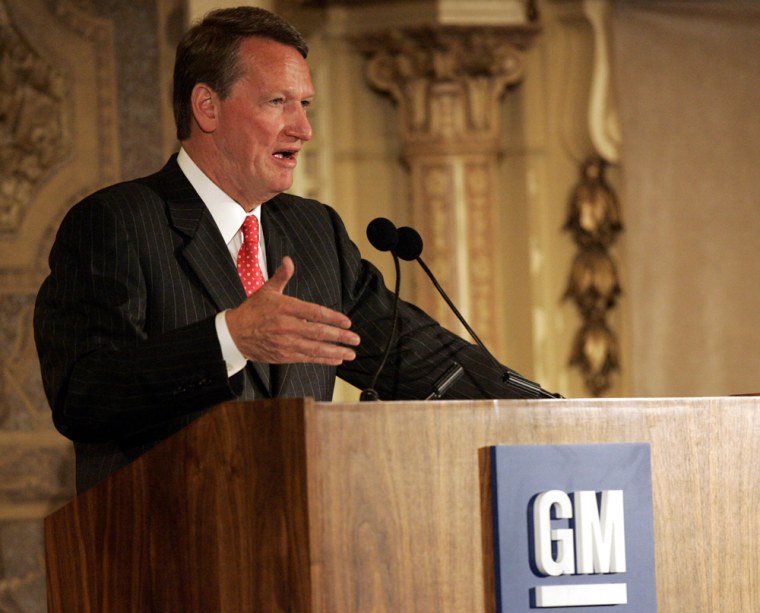General Motors Corp. may be closing more plants and eliminating the jobs of one of every six employees in the United States, but the world’s largest automaker isn’t going out of business anytime soon.
That’s the point Chairman and CEO Rick Wagoner tried to make repeatedly and as clearly as possible Tuesday at a sometimes contentious gathering of GM shareholders in Delaware at the company’s 97th annual meeting.
But even as Wagoner laid out a four-step plan to revive GM’s troubled North American business — the crux of which involves eliminating 25,000 manufacturing jobs by 2008 from its U.S. workforce of 150,000 — he acknowledged there’s only so much the carmaker can control as it attempts a financial turnaround.
“If the U.S. market booms, if gas prices go down, if large SUVs come back, then our return to profitability will be quicker,” Wagoner said. “If the U.S. enters into a downturn and gas prices go much higher ... it’s going to be a tougher job.”
Wagoner is promising big changes for GM’s eight brands. Chevrolet and Cadillac will continue to have full vehicle lineups, he said, but GMC, Pontiac, Buick, Saturn, Saab and Hummer will be more tightly focused on niche markets. “In some cases, such as Pontiac and Buick, it will mean fewer but stronger entries in the future,” he said.
At GM, it hasn’t been this tough since the company barely escaped financial collapse in the early 1990s. Back then, it was Wagoner himself who took over North American operations and is credited with helping the automaker make great strides in quality and efficiency in the past decade.
These days, Wagoner and GM are facing perhaps an even tougher challenge: increased competition from Asian automakers and skyrocketing health care costs and pension obligations that contributed to a $1.1 billion loss in the first quarter.
GM’s stock, which recently fell to a 10-year low as its U.S. market share slumped to 25.4 percent from 27 percent a year earlier, would be even lower today if not for a move by billionaire investor Kirk Kerkorian to acquire 28 million shares for $31 apiece. Kerkorian’s offer was scheduled to expire on Tuesday.
General Motors shares rose 31 cents, or 1 percent, to $30.73 in trading Tuesday on the New York Stock Exchange.
Wagoner told shareholders Tuesday that health-care expenses add $1,500 to the cost of each GM vehicle. This puts GM at a “significant disadvantage versus foreign-based competitors,” Wagoner said, echoing comments made by the Standard & Poor’s and Fitch ratings services after both reduced the company’s bond rating to “junk” status last month.
Wagoner described as intense the status of ongoing negotiations with the United Auto Workers and other unions on ways to significantly reduce GM’s health-care costs. GM’s health-care tab for its 1.1 million current and former workers and their families is more than $5 billion a year and rising.
“We have not reached an agreement at this time, and to be honest, I’m not 100 percent that we will,” said Wagoner, the CEO since 2000 and chairman since 2003.
To date, the UAW has indicated it won’t reopen its contract, which expires in 2007, and agree to pick up a larger share of soaring health care.
Wagoner, who fended off calls for his resignation from shareholders, said the capacity and job cuts should generate annual savings of roughly $2.5 billion.
The cuts would be on top of earlier reductions that pared GM’s U.S. workforce from 177,000 hourly and salaried employees at the end of 2000 to 150,000 at the end of last year, according to figures provided by GM.
“Let me say up front that our absolute top priority is to get our largest business unit back to profitability as soon as possible,” said Wagoner, who added that with $20 billion in cash and short-term investments, GM is in no danger of going out of business anytime soon.
Wagoner wouldn’t say which plants are in danger of being closed, but David Cole, chairman of the Center for Automotive Research in Ann Arbor, Mich., said the most likely targets are several older plants. Those include facilities in Janesville, Wis.; Doraville, Ga.; Oklahoma City and Pontiac, Mich., he said. The Janesville plant was built in 1919 and the Doraville plant was built in 1947. The other two plants were built in the 1970s.
Cole said GM probably won’t close plants that have recently undergone costly renovations, such as the plant in Lordstown, Ohio, that recently got $1 billion worth of upgrades.
Disgruntled shareholders gave Wagoner an earful Tuesday.
“This company is sick,” said James Dollinger, a Buick salesman from Flint, Mich., who angrily told Wagoner he should resign.
Fellow shareholder John Lauve compared the GM leadership to officers aboard the Titanic as it headed for an iceberg. “The Titanic sank because the directors ignored the warnings,” said Lauve, who criticized everything from gas gauges in GM vehicles to the company’s health-care cards. “We need to excel at the basics.”
Wagoner said GM board members seem satisfied with the details of the proposed turnaround strategy and feel the best executives are in place to accomplish it.
“No one’s job security is forever, and that applies to me,” Wagoner said. “But I’m very confident we have the right plans and I have the full support of the board and frankly the full support of the key constituents in our company.”
